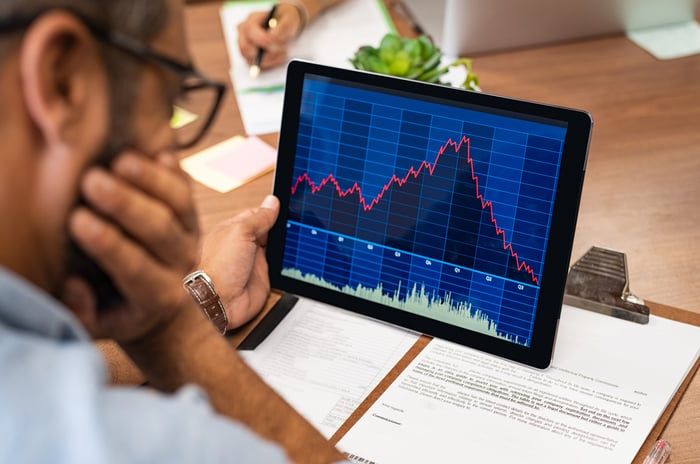|
|
|

|
|||||

|
|
History has repeatedly shown that next-big-thing technologies and innovations need ample time to mature.
Despite a sky-high addressable market, artificial intelligence (AI) may be the next in a long line of bubbles to burst on Wall Street.
However, AI isn't alone, with two other hot trends highly unlikely to sustain their parabolic ascents or insatiable hype.
For more than three decades, investors have typically had a game-changing innovation or next-big-thing technology to captivate their attention and wallet. Perhaps the best example is the advent and proliferation of the internet in the mid-1990s, which sent the benchmark S&P 500 (SNPINDEX: ^GSPC), iconic Dow Jones Industrial Average (DJINDICES: ^DJI), and growth-focused Nasdaq Composite (NASDAQINDEX: ^IXIC) soaring.
The internet paved the way for businesses to move beyond their traditional storefronts. It also revolutionized investing and broke down information barriers that had previously existed between Wall Street and Main Street. Having instant access to income statements, balance sheets, management commentary, and corporate presentations made investors more willing to accept valuation premiums for internet-driven businesses that promised jaw-dropping growth rates.
Where to invest $1,000 right now? Our analyst team just revealed what they believe are the 10 best stocks to buy right now. Learn More »

Image source: Getty Images.
However, the internet revolution wasn't without its speed bumps. As history has consistently shown, every new technology or trend has needed time to mature. In simpler terms, it takes time for businesses to figure out how to optimize new technologies. This leaves the stock market and the companies on the leading edge of these trends susceptible to bubble-bursting events, such as the bursting of the dot-com bubble in the early 2000s.
Other next-big-thing technologies and trends followed suit, with genome decoding, nanotechnology, 3D printing, blockchain technology, and the metaverse representing examples of eventual bubble-bursting events.
Typically, game-changing innovations and trends are singular events, with one hyped innovation or trend existing at a time. But we may be witnessing history, with three potential bubbles brewing at the same time.
Arguably, no technological innovation since the internet has excited Wall Street and investors quite like the evolution of artificial intelligence (AI). Based on estimates from PwC analysts in Sizing the Prize, a combination of productivity improvements and consumption-side effects derived from AI can add $15.7 trillion to global gross domestic product by 2030.
Powerhouses like Nvidia (NASDAQ: NVDA) and Palantir Technologies (NASDAQ: PLTR) have led the way from a hardware and application standpoint. Nvidia's graphics processing units (GPUs) are the brains powering decision-making in high-compute data centers. Meanwhile, Palantir's AI- and machine learning-driven Gotham platform is helping federal governments plan and execute military missions, as well as collect and analyze data. Both companies have sustainable moats and jaw-dropping growth rates, courtesy of AI.
Something else these AI leaders possess is historically troublesome valuations. History tells us that public companies on the leading edge of next-big-thing technologies typically peak at price-to-sales (P/S) ratios of 30 to 40. Nvidia headed into its latest earnings report with a P/S ratio of nearly 30, while Palantir Technologies is sporting a P/S ratio of 115. Neither P/S ratio has proved sustainable for any extended period, based on historical precedent.
More importantly, most businesses that are aggressively investing in AI-data center infrastructure and AI-powered applications have yet to optimize their hardware or software.
With the advent of the internet, it took years before businesses figured out how to harness this technology to boost their sales and margins. This hasn't happened yet with artificial intelligence, which leaves this trend wide open for an eventual bubble-bursting event.

Image source: Getty Images.
Whereas AI has been captivating the attention of investors for almost three years, the rise of quantum computing has been a scorching-hot trend for approximately one year.
Quantum computing relies on the principles of quantum mechanics to solve complex equations and problems that traditional computer systems can't handle. Specialized quantum computers may be able to aid with drug research and development, climate modeling, supply chain optimization, and can potentially expedite machine learning by vastly speeding up AI algorithms. This sampling of use cases is what has Boston Consulting Group believing this technology can add up to $850 billion in economic value by 2040.
Though some members of the "Magnificent Seven" are developing hardware or platforms catering to quantum computing, pure-play quantum computing stocks have skyrocketed. Over the trailing year (as of the closing bell on Aug. 27), IonQ (NYSE: IONQ) and Rigetti Computing (NASDAQ: RGTI) have seen their shares gain 452% and 1,530%, respectively.
Unfortunately, neither IonQ nor Rigetti has demonstrated that their operating models are sustainable or scalable. IonQ is expected to report $91 million in full-year sales in 2025 but is valued at north of $12 billion. As for Rigetti, full-year revenue is expected to decline to just $8 million this year, which compares to its roughly $5 billion market cap.
Additionally, IonQ and Rigetti aren't particularly close to generating a profit, even with projections of rapid sales growth in 2026. Similar to the metaverse, this technology looks to be a long way off from becoming mainstream and truly relevant.
The third potential bubble brewing alongside steep (and likely unsustainable) climbs in AI and quantum computing is the Bitcoin (CRYPTO: BTC) treasury strategy. This involves public companies using their cash, or issuing common stock and/or debt, to acquire Bitcoin to hold on their balance sheet.
The primary lure of the Bitcoin treasury strategy is to fight back against inflation. The U.S. money supply continues to expand, which is devaluing the dollar over time. In comparison, Bitcoin's lifetime token supply, once fully mined, is limited to 21 million coins. This perceived scarcity fuels the bull case and is a key reason Michael Saylor's Strategy (NASDAQ: MSTR) has acquired 632,457 Bitcoin, or more than 3% of the total tokens that'll ever be in circulation.
Dozens of public companies have followed in Strategy's footsteps by creating a Bitcoin treasury, with the hope that Bitcoin will continue to appreciate in value. While these purchases have helped to temporarily and artificially inflate the price of Bitcoin, it's not sustainable.
Strategy aside, many of the companies adopting Bitcoin treasuries are struggling businesses that are losing money and falling behind on the innovation front. Buying Bitcoin (or any cryptocurrency) isn't a panacea to these struggles. Further, most businesses are diluting their shareholders by issuing stock or some form of debt to buy Bitcoin, which leaves these companies open to the possibility of having to unload their digital assets if a shock event were to occur.
To add, most Bitcoin Treasury companies (Strategy included) are trading at significant premiums to the net asset value of their Bitcoin. Instead of purchasing Bitcoin directly or using an exchange-traded fund to gain Bitcoin exposure, investors are paying premiums that can sometimes exceed 500% of the actual value of the digital assets held by unproven/structurally insolvent businesses.
With Bitcoin enduring more than a half-dozen declines of at least 50% since its inception, it seems to be only a matter of time before the Bitcoin Treasury strategy implodes.
Before you buy stock in Nvidia, consider this:
The Motley Fool Stock Advisor analyst team just identified what they believe are the 10 best stocks for investors to buy now… and Nvidia wasn’t one of them. The 10 stocks that made the cut could produce monster returns in the coming years.
Consider when Netflix made this list on December 17, 2004... if you invested $1,000 at the time of our recommendation, you’d have $664,110!* Or when Nvidia made this list on April 15, 2005... if you invested $1,000 at the time of our recommendation, you’d have $1,104,355!*
Now, it’s worth noting Stock Advisor’s total average return is 1,069% — a market-crushing outperformance compared to 186% for the S&P 500. Don’t miss out on the latest top 10 list, available when you join Stock Advisor.
*Stock Advisor returns as of August 25, 2025
Sean Williams has no position in any of the stocks mentioned. The Motley Fool has positions in and recommends Bitcoin, Nvidia, and Palantir Technologies. The Motley Fool has a disclosure policy.
| 14 min | |
| 15 min | |
| 24 min | |
| 26 min | |
| 26 min | |
| 30 min | |
| 41 min | |
| 41 min | |
| 43 min | |
| 54 min | |
| 56 min | |
| 1 hour | |
| 1 hour | |
| 1 hour | |
| 1 hour |
Palantir Stock Falls As Investors Mull Q3 Earnings Beat, Guidance, Premium Valuation
PLTR
Investor's Business Daily
|
Join thousands of traders who make more informed decisions with our premium features. Real-time quotes, advanced visualizations, backtesting, and much more.
Learn more about FINVIZ*Elite